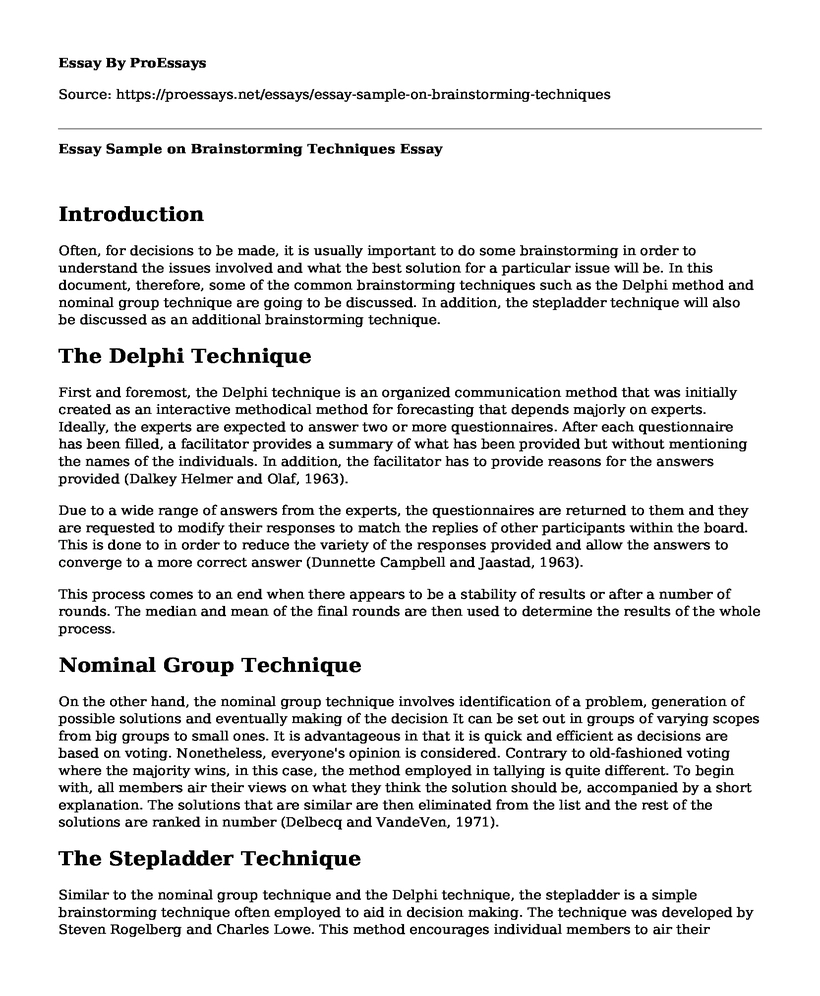Introduction
Often, for decisions to be made, it is usually important to do some brainstorming in order to understand the issues involved and what the best solution for a particular issue will be. In this document, therefore, some of the common brainstorming techniques such as the Delphi method and nominal group technique are going to be discussed. In addition, the stepladder technique will also be discussed as an additional brainstorming technique.
The Delphi Technique
First and foremost, the Delphi technique is an organized communication method that was initially created as an interactive methodical method for forecasting that depends majorly on experts. Ideally, the experts are expected to answer two or more questionnaires. After each questionnaire has been filled, a facilitator provides a summary of what has been provided but without mentioning the names of the individuals. In addition, the facilitator has to provide reasons for the answers provided (Dalkey Helmer and Olaf, 1963).
Due to a wide range of answers from the experts, the questionnaires are returned to them and they are requested to modify their responses to match the replies of other participants within the board. This is done to in order to reduce the variety of the responses provided and allow the answers to converge to a more correct answer (Dunnette Campbell and Jaastad, 1963).
This process comes to an end when there appears to be a stability of results or after a number of rounds. The median and mean of the final rounds are then used to determine the results of the whole process.
Nominal Group Technique
On the other hand, the nominal group technique involves identification of a problem, generation of possible solutions and eventually making of the decision It can be set out in groups of varying scopes from big groups to small ones. It is advantageous in that it is quick and efficient as decisions are based on voting. Nonetheless, everyone's opinion is considered. Contrary to old-fashioned voting where the majority wins, in this case, the method employed in tallying is quite different. To begin with, all members air their views on what they think the solution should be, accompanied by a short explanation. The solutions that are similar are then eliminated from the list and the rest of the solutions are ranked in number (Delbecq and VandeVen, 1971).
The Stepladder Technique
Similar to the nominal group technique and the Delphi technique, the stepladder is a simple brainstorming technique often employed to aid in decision making. The technique was developed by Steven Rogelberg and Charles Lowe. This method encourages individual members to air their opinions before being influenced by anyone else. Consequently, a wide range of results is obtained as every member is given the chance to participate. In addition, it helps the shy members from being overpowered by stronger members of the group (Osorio, 2012).
This technique involves a number of stages. The first stage involves presenting the problem to all members and giving every member enough time to think about the solutions to the problem. Thereafter, a group of two members is formed and they are allowed to discuss the issue. More members are added one after the other as the discussion continues, and a final decision is reached upon when all the members have presented all their ideas (Jenkins, 1994).
Conclusion
In a nutshell, this technique proves to be more advantageous where the decision to be made involves a large group of people as each of the members receives an equal chance to air their opinions before the decision is reached upon.
References
Dalkey, Norman; Helmer, Olaf (1963). "An Experimental Application of the Delphi Method to the use of experts". Management Science. 9 (3): 458-467.
Delbecq, A. L.; VandeVen, A. H (1971). "A Group Process Model for Problem Identification and Program Planning". Journal of Applied Behavioral Science. 7: 466-91.
Dunnette, M D.; Campbell, J. D; Jaastad, K. (1963). "The Effect of Group Participation on Brainstorming Effectiveness for Two Industrial Samples". Journal of Applied Psychology. 47: 30-37.
Jenkins, M. (1994). A methodology for creating and comparing strategic causal maps.
Osorio, F. A. (2012). A multi-actor analysis approach in decision making: A framework to complement ISA-95 guidelines within manufacturing companies.
Cite this page
Essay Sample on Brainstorming Techniques. (2022, Aug 08). Retrieved from https://proessays.net/essays/essay-sample-on-brainstorming-techniques
If you are the original author of this essay and no longer wish to have it published on the ProEssays website, please click below to request its removal:
- How the Psychological Contract Can Be Integrated in Skyline International
- Ethical Dilemmas and Ethical Decision Making Essay
- Improving Communication at the Workplace - Essay Sample
- Essay Sample on Strategies Used by Adidas Group to Enter New Markets
- Paper Example on RAMS Project Evaluation: Achieving Success Through Collaboration
- Paper Example on Project Management: The Pressure to Deliver on Time & Budget
- Assessing Team Dynamics: Strengths, Trust & Leadership - Essay Sample







